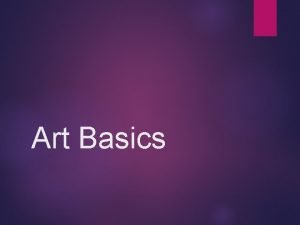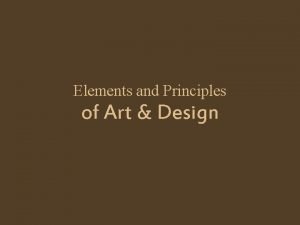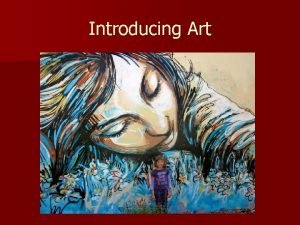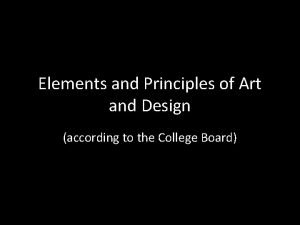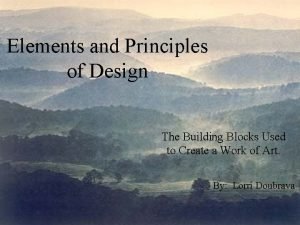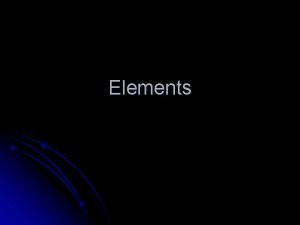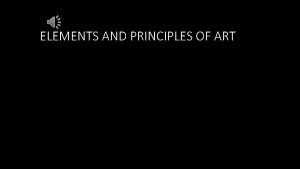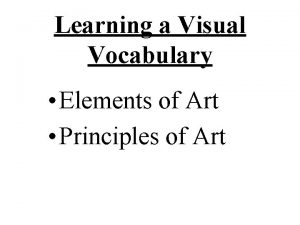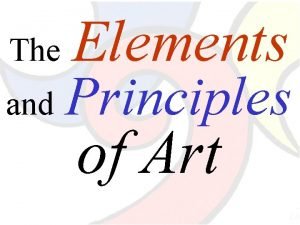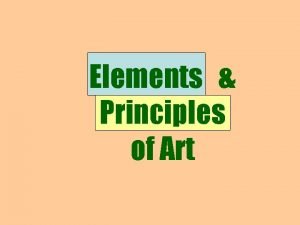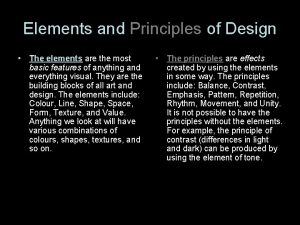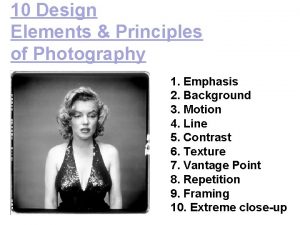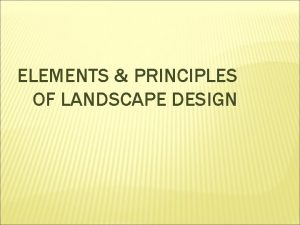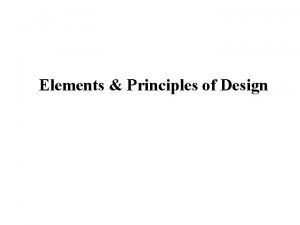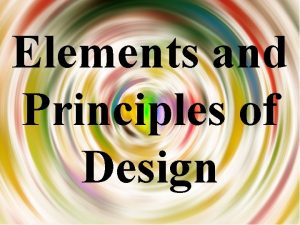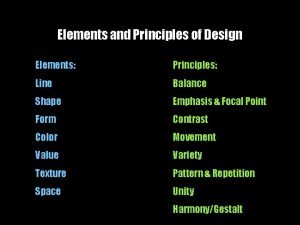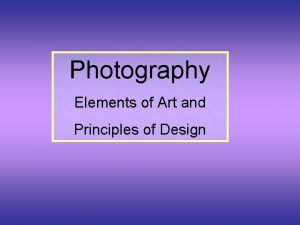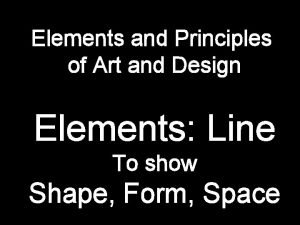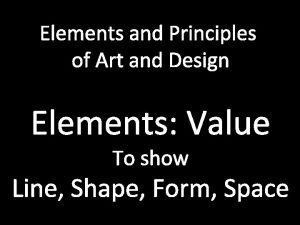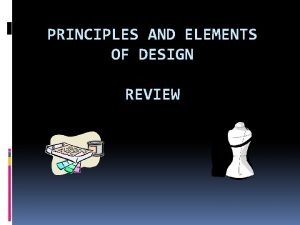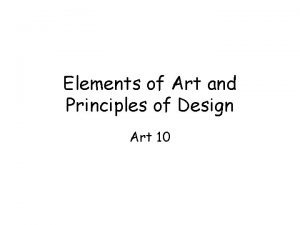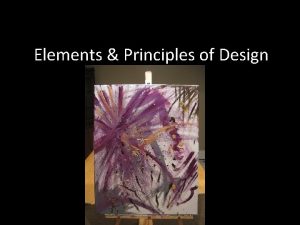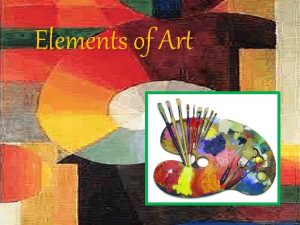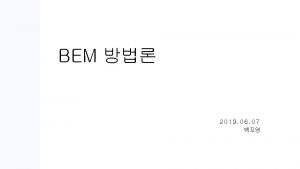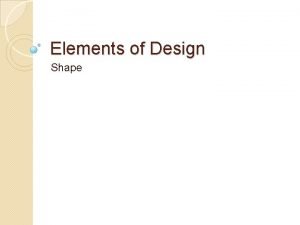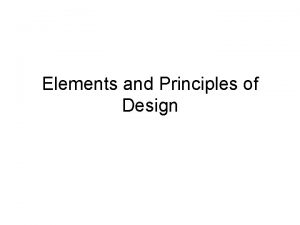Elements and Principles of Art and Design Element


























- Slides: 26

Elements and Principles of Art and Design Element: Color Hue: Technical Term for Color Pigment: Physical Material of Color

Painting Materials 1. 2. 3. 4. 5. 6. Paint palette Acrylic Paint brushes Cup of water Paper Towel Sketchbook / Paper

Paint Pump Tips Only take a dime-size amount of paint (you can always go back for more) If paint does not come out of the pump easily, STOP. 1. Get a paper towel and cover the opening of the spout and push the pump. 2. If paint does not come out, find a pair of scissors or a sharp/narrow object. 3. Use the object to clear any dried paint from the spout. Try to push again.

Painting Tips Add dark colors to light colors (never light to dark) Only mix as much as you need: be conservative and do not waste paint Wash your brush and pat dry with paper towel for each different color

Cleaning Your Brush Rinse brush thoroughly and carefully under warm water. Massage bristles to work out any paint left. Squeeze the bristles. If the water comes out clear, the brush is clean.

Order of Paint on Palette Only a dime-size 1. Cool Red glob of paint 2. Warm Red at a time! 3. Warm Yellow 4. Cool Yellow 5. Cool Blue 6. Warm Blue

Primary Colors Red, Yellow, Blue Can create any color when mixed, along with black and white Cannot be created from mixing other colors

Secondary Colors Orange, Green, Violet Creating by mixing 2 primary colors together

Tertiary Colors Red-Orange, Yellow-Green Blue-Green, Blue-Violet, Red-Violet Creating by mixing 1 primary color and 1 adjacent secondary color together

Color Wheel

Color Temperature Warm Colors (Fire, Sun, Heat): Cool Colors (Ice, Cold, Night):

Opaque vs. Transparent: Can see through it To Increase Transparency: Add Water Opaque: Cannot see through it To Increase Opacity: - Add more pigment, less water - Add more layers of paint

Value (in color): The lightness or darkness of a hue Tinting: Adding white to make a hue lighter Shading: Adding black to make a hue darker Toning: Adding gray to desaturate a color (Be careful: this dulls & flattens color)

Color Scheme An arrangement or combination of colors used in a work of art Monochromatic Analogous Complementary

Monochromatic Color Scheme All the values (tints, tones, and shades) of one particular hue Creates balance, unity, and harmony

Monochromatic

Monochromatic

Analogous Color Scheme Three or four hues (MAX 5) that are adjacent on the color wheel (includes tertiaries) Creates balance, unity, and harmony, with some variety and contrast

Analogous

Analogous

Complementary Color Scheme Two hues that are opposite each other on the color wheel When placed next to each other: They create energy and contrast, make each other *POP*

Complementary

Complementary

Complementary

Complementary Colors When mixed together: They desaturate each other, create a brown or gray

Saturation vs. Desaturation Saturation: The vibrancy, purity, and intensity of a hue *A highly saturated color is vibrant, pure, intense Desaturate: Decrease the saturation of a hue to create a duller, more brown-gray hue
 Da vinci
Da vinci Element and principles of art
Element and principles of art Elements and principles of art
Elements and principles of art A feeling of visual equality in shape form value color
A feeling of visual equality in shape form value color Elements and principles of art
Elements and principles of art It is the path our eyes follow when we look at work of art
It is the path our eyes follow when we look at work of art Rhythm and balance in art
Rhythm and balance in art Basic elements of music play theater
Basic elements of music play theater Subject matter
Subject matter Kinds of elements and principles of arts
Kinds of elements and principles of arts Elements principles of art
Elements principles of art Elements principles of art
Elements principles of art Lines have a definite forward or backward
Lines have a definite forward or backward Which lines create length and height in a hair design
Which lines create length and height in a hair design Tension in floral design
Tension in floral design Principles of design
Principles of design Elements of interior design ppt
Elements of interior design ppt Visual design principles and elements matrix
Visual design principles and elements matrix Elements and principles of design fashion
Elements and principles of design fashion Design elements and principles of the universe
Design elements and principles of the universe Repetition or reoccurrence of a design element
Repetition or reoccurrence of a design element Rhythm stone
Rhythm stone Elements and principles of landscape design
Elements and principles of landscape design What are the elements and principles of design
What are the elements and principles of design What are the elements and principles of design
What are the elements and principles of design Visual elements and principles of design
Visual elements and principles of design Photography elements and principles of design
Photography elements and principles of design
